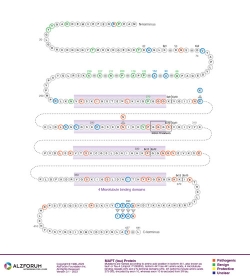Mutations
MAPT D252V
Quick Links
Overview
Pathogenicity: Frontotemporal Dementia : Unclear Pathogenicity
Clinical
Phenotype: Frontotemporal Dementia
Position: (GRCh38/hg38):Chr17:45996597 A>T
Position: (GRCh37/hg19):Chr17:44073963 A>T
dbSNP ID: NA
Coding/Non-Coding: Coding
DNA
Change: Substitution
Expected RNA
Consequence: Substitution
Expected Protein
Consequence: Missense
Codon
Change: GAC to GTC
Reference
Isoform: Tau Isoform Tau-F (441 aa)
Genomic
Region: Exon 9
Findings
This mutation was identified in a man diagnosed with frontotemporal dementia at age 46 (Shafei et al., 2019). This patient presented with behavioral symptoms and language difficulties, and also showed signs of memory impairment. MRI revealed asymmetric atrophy of the temporal and frontal lobes, with the left side more severely affected than the right. Behavior and cognitive function continued to worsen, and the patient died at age 54.
A family history of dementia was reported, with the proband’s mother and six of her seven siblings said to have developed “dementia” in their 60s or 70s. Genetic data were not available from other family members, precluding segregation analysis.
This mutation was absent in gnomAD and in more than 3000 in-house subjects, including healthy controls and neurological patients with diagnoses other than FTD.
Neuropathology
At autopsy, the patient’s brain showed widespread atrophy, which was particularly severe in the temporal and frontal lobes, the caudate nucleus, the hippocampus, and the amygdala. Tau inclusions—neurofibrillary tangles, pretangles, neuropil threads, and Pick bodies—were found throughout the atrophied regions. Neuronal inclusions were composed of 3R-tau, while astrocytic inclusions contained 4R-tau.
There was no evidence of amyloid deposits or α-synuclein or TDP-43 pathology.
Biological Effect
CADD predicted the D252V variant is deleterious (Shafei et al., 2019).
Last Updated: 03 Jan 2020
References
Paper Citations
- Shafei R, Woollacott IO, Mummery CJ, Bocchetta M, Guerreiro R, Bras J, Warren JD, Lashley T, Jaunmuktane Z, Rohrer JD. Two pathologically confirmed cases of novel mutations in the MAPT gene causing frontotemporal dementia. Neurobiol Aging. 2020 Mar;87:141.e15-141.e20. Epub 2019 Nov 20 PubMed.
Further Reading
No Available Further Reading
Protein Diagram
Primary Papers
- Shafei R, Woollacott IO, Mummery CJ, Bocchetta M, Guerreiro R, Bras J, Warren JD, Lashley T, Jaunmuktane Z, Rohrer JD. Two pathologically confirmed cases of novel mutations in the MAPT gene causing frontotemporal dementia. Neurobiol Aging. 2020 Mar;87:141.e15-141.e20. Epub 2019 Nov 20 PubMed.
Alzpedia
Disclaimer: Alzforum does not provide medical advice. The Content is for informational, educational, research and reference purposes only and is not intended to substitute for professional medical advice, diagnosis or treatment. Always seek advice from a qualified physician or health care professional about any medical concern, and do not disregard professional medical advice because of anything you may read on Alzforum.


Comments
No Available Comments
Make a Comment
To make a comment you must login or register.